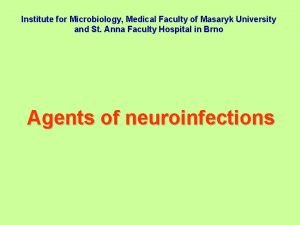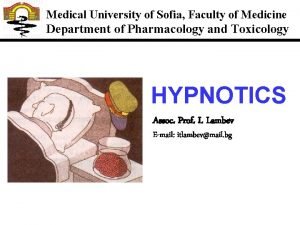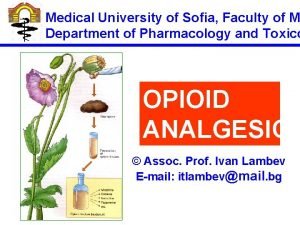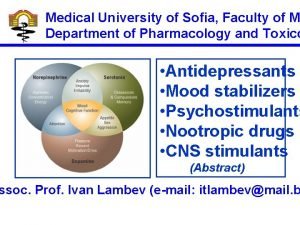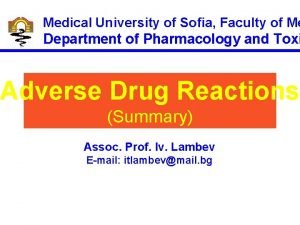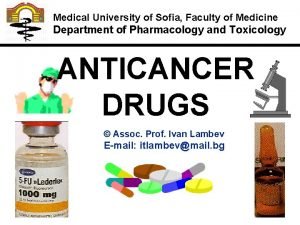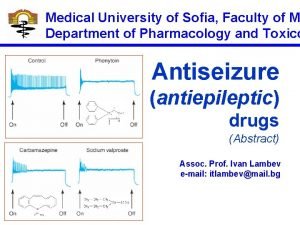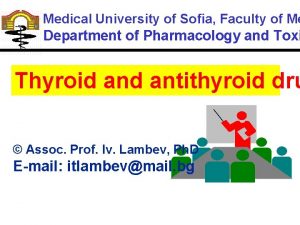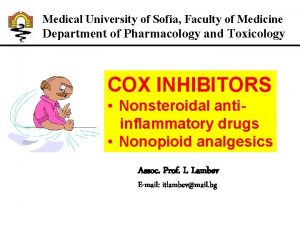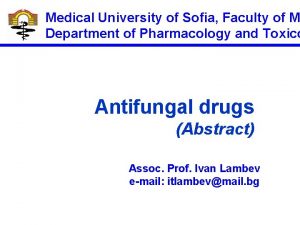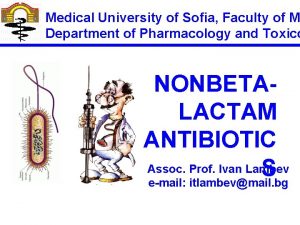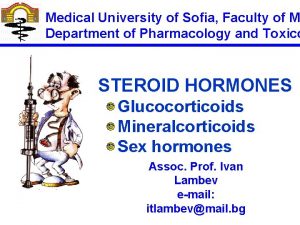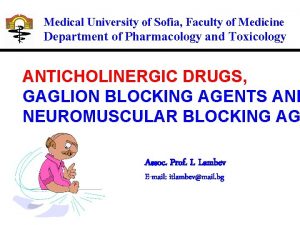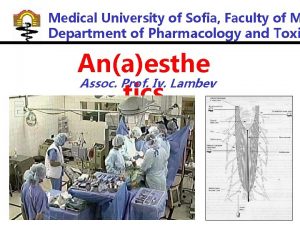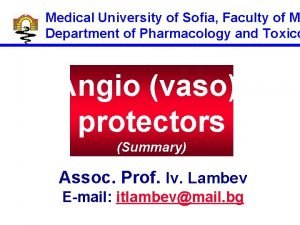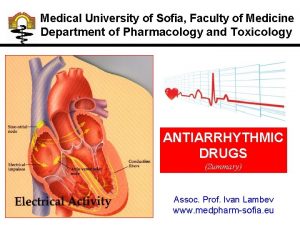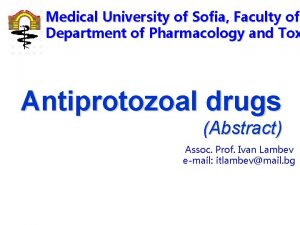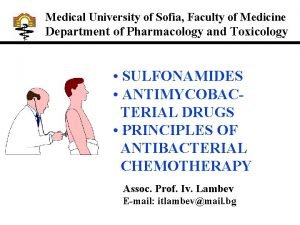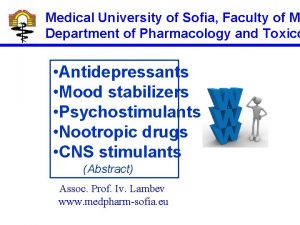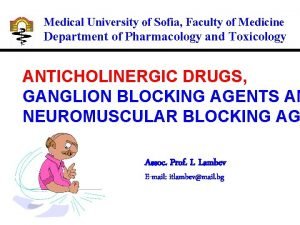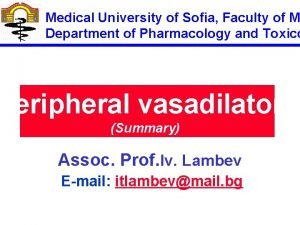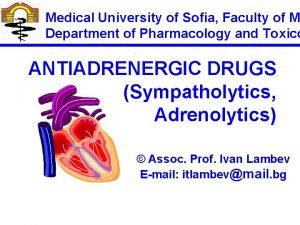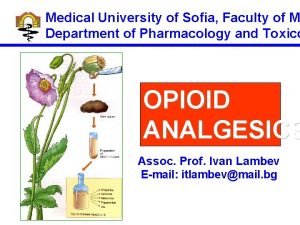Medical University of Sofia Faculty of M Department





























- Slides: 29

Medical University of Sofia, Faculty of M Department of Pharmacology and Toxico Antiparkinsonian drugs (Abstract) Assoc. Prof. Ivan Lambev e-mail: itlambev@mail. bg

Parkinson’s disease (PD) is a progressive neurodege disorder. It is first described by James Parkinson in 1817 PD affects 5 in 200 of the elderly population. It causes by degeneration of substantia nigra in the midbrain, and consequent loss of DA-containing neurons in the nigrostr pathway. Two balanced systems are important in the extrapyramidal control of motor activity at the level of the striatum and substantia nigra; in one the neurotransmitter ACh; in the other it is DA. The symptoms of PD are connected with loss of nigro neurons and DA depletion. The symptomatic triad inclu bradykinesia, rigidity and tremor with secondary manif like defective posture and gait, mask like face and sialorr dementia may accompany.

Clinical Pharmacology – 9 th Ed. (2003)

Distribution and characteristics of DA receptors in the central nervous system Goodman & Gilman's The Pharmacologic Basis of Therapeutics - 11 th Ed. (2

The normally high concentration of DA in the basal gangli brain is reduced in PD, and pharmacologic attempts to re DA-ergic activity with levodopa and DA agonists have bee successful in alleviating many of the clinical features of th An alternative but complementary approach has been to r normal balance of cholinergic and dopaminergic influence basal ganglia with antimuscarinic drugs. The pathophysio for this therapy is that in idiopathic parkinsonism, dopamin neurons in the substantia nigra that normally inhibit the ou GABA-ergic cells in the corpus striatum are lost. In contrast, Huntington's chorea involves the loss of som ergic neurons and an even greater loss of the GABA-ergi exit the corpus striatum. Drugs that induce parkinsonian s are DA receptor antagonists (e. g. , antipsychotic agents) l the destruction of the DA-ergic nigrostriatal neurons.

Rang et al. Pharmacology – 5 st Ed. (2003)

The cause of selective degeneration of nigrostrial neuron is not precisely known. It appears to be multifactorial. Oxi DA by MAO-B and aldehyde dehydrogenase generate hy free radicals (˙OH) in the presence of ferrous iron (basal are rich in iron). Normally these radicals are quenched by thione and other endogenous antioxidants. Age-related (e atherosclerosis) and/or otherwise acquired defect in prote antioxidant mechanisms allows the free radicals damage membranes and DNA resulting in neuronal degenerations tic predisposition may contribute to high vulnerability of su nigra neurons. Environmental toxins or some infections (g may accentuate these defects. A synthetic toxin N-methy tetrahydropyridine (MPTP), which occurred as a contamin some illicit drugs, produces nigrostrial degenerations sim Neuroleptics and other DA blockers may cause temporar

Production of free radical by the metabolism of dopam DA is converted by MAO and aldehyde dehydrogenase (A 3, 4 -dihydroxyphenylacetic acid (DOPAC), producing hydr peroxide (H 2 O 2). In the presence of ferrous ion hydrogen oxide undergoes spontaneous conversion, forming a hydr free radical (The Fenton reaction). Goodman & Gilman's The Pharmacologic Basis of Therapeutics - 11 th Ed. (2

Grippe Essential of Medical Pharmacology – 5 st Ed. (2003) Factors contributing to degeneration of nigrostrial DA-ergic neurones causing PD

The key steps in the synthesis and degradation of dopamine and the sites of action of various psychoactive substances at the dopaminergic synapse

Objectives of antiparkinsonian pharmaco The dopaminergic/cholinergic balance may be restored by two mechanisms. 1. Enhancement of DA-ergic activity by drugs which m (a) replenish neuronal DA by supplying levodopa, which is its natural precursor; administration of DA itself is ineffective as it does not cross the BBB; (b) act as DA agonists (bromocriptine, pergolide, cabergo (c) prolong the action of DA through selective inhibition o metabolism (selegiline); (d) release DA from stores and inhibit reuptake (amantad 2. Reduction of cholinergic activity by antimuscarinic drugs; this approach is most effective against tremor and less effective in the treatment of bradykinesia.

Central DA-ergic Drugs Levodopa Dopamine (-) Selegiline MAO-B (-) Amantadine Reuptake Amantadine (+) The Principles of Medical Pharmacology (1994) D 2 -receptors Bromocriptin Pergolide

▼LEVODOPA (dopa – Dihydro. Oxy. Phenyl. Alanine; (t 1/2 1, 5 h) is a natural amino acid precursor of DA. The major disadvantage is the extensive decarboxylation of levodopa to DA in periferal tissues. So that only 1– 3% of an oral dose reaches to the brain.

Basic & Clinical Pharmacology – 10 th Ed. (2007)

Thus large quantities of levodopa would have to be given Levodopa and its metabolites cause significant adverse r (ARs) by peripheral actions, notably nausea, arrhythmia, hypertension. This problem has been largely circumvente decarboxylase inhibitor (benserazide, carbidopa), whic enter the CNS; they prevent only the extracerebral metab of levodopa. The inhibitors are given in combination with levodopa; but in this case only 25% of the dose of levodo required and ARs diminish significantly. Levodopa alone combination is introduced gradually and titrated accordin clinical response; the dose being altered every two week • Co-careldopa (carbidopa and levodopa in proportions 12. 5/50 mg, 25/100 mg, 25/250 mg) – Sinemet®. • Co-beneldopa (benserazide and levodopa in proportio 12. 5/50 mg, 25/100 mg, 50/200 mg) – Madopar®.

Basic & Clinical Pharmacology – 10 th Ed. (2007)

▼BROMOCRIPTINE (t 1/2 5 h) – a derivative of ergot (E savle, Secale cornutum). It is a D 2 -receptor agonist, bu a weak alpha-adrenoceptor anatagonist. Bromocriptine monly used with levodopa. It should be started at very lo doses (1– 1, 25 mg p. o. at night), increasing at weekly in and according to clinical response. It is also used for tre of prolactin-secreting adenomas, amenorrhea/galactorrh hyperprolactinemia, to stop lactation, acromegaly. ARs: Nausea and vomiting, which may be prevented w domperidone; postural hypotension (may cause dizzine syncope); in high doses – confusion, delusions or halluc tions; after prolonged use – pleural effusion and retrope toneal fibrosis.

▼CABERGOLINE, also an ergot derivative, has a t 1/2 > This allows it to be used in a single daily (or even twice dose. Cabergoline alleviates night-time problems in par nian patients due to lack of levodopa. ▼PRAMIPEXOLE is a non-ergot D 2 -receptor agonist; i more effective against tremor than the others. ▼ROPINIROLE (Requip®) is a new non-ergot direct D 2 -receptor agonist. There are insufficient data to allow an informed choice between pramipexole and ropinirole ▼ENTACAPONE inhibits COMT (catechol-O-methyltra pherase), one of the main enzymes responsible for the metabolism of DA; the action of levodopa is thus prolon Entacapone is most effective for patients with early end-of-dose deterioration.

▼SELEGILINE is a selective irreversible inhibitor of MA The problem with nonselective MAO inhibitors is that the degradation of dietary adrenomimetic amines, especially tyramine, which causes hypertensive “cheese reaction”. Selegiline does not cause the cheese reaction, because MAO-A is still presented in the liver to metabolize tyrami MAO-A also metabolizes tyramine in the sympathetic ne endings in periphery. Selegiline inhibit selectively only M in the CNS and protects DA from intraneuronal degradat It is used as an adjunct drug in PD if levodopa/carbidopa levodopa/benserazide therapy is deteriorating. ARs: mood changes, dizziness, vomiting, xerostomia, abdominal pain, dyskinesias, arrhythmias, hallucinations confusion, insomnia.

AMANTADINE is an antivirus drug which, given for influen o a parkinsonian patient, was noted to be beneficial. Antivira and antiparkinsonian effects of amantadine are probably unrelated. Antiparkinsonian effect is due to increase synthesis and release of DA, and diminish neuronal reuptake too. Amantadine also has slight antimuscarinic effect. It is used for oral adjunct treatment of PD and influenza A virus infection. Amantadine is relatively free from ARs, which, however, includes ankle edema (probably a local effect on blood vessels), orthostatic hypotension, insomnia, hallucinations, rarely – fits.

Central antimuscarinic drugs Atropa belladonna L. (Deadly night shade) Radix Belladonnae: (cura bulgara) – atropine Belladonna roots have been empirically used fo treatment of PD in 1920 s in Bulgaria by Ivan Ra

▼BIPERIDEN, TRIHEXIPHENIDYL, TRIPERIDEN are synthetic compounds (central M-cholinolytics). They parkinsonism by blocking ACh receptors in the CNS, the partially redressing the imbalance created by decreased activity. They also produce modest improvement in tremo rigidity, sialorrhoea (hypersalivation), muscular stiffness cramp, but little in bradykinesia, which is the most disabl symptom of Parkinson’s disease. ARs of antimuscarinic include dry mouth (xerostomia), blurred vision, constipati urine retention (retentio urinae), glaucoma, hallucinations memory defects, toxic confusional states and psychoses (which should be distinguish from presenile dementia).


Pharmacotherapy of PD (Clinical Pharmacology – 9 th Ed. , 2003) The main features that require alleviation are tremor, rig and bradykinesia. Drug therapy has the most important symptom relief, but it does not alter the progressive cour Treatment should begin only when it is judged necessary each individual case. Two conflicting objectives have to be balanced: the desire for satisfactory relief of current s and the avoidance of ARs as a result of long-continued t There is a debate as to whether the treatment should co with levodopa or a synthetic DA agonist. Levodopa provi the biggest improvement in motor activity but its use is a with the development dyskinesia (involuntary movement of the face and limbs) after 5– 10 years, and sometimes s

DA agonists have a much less powerful motor effect but likely to produce dyskinesias. The treatment usually beg levodopa in low doses to get a good motor response and a DA agonist when the initial benefit begins to wane. A typical course is that for about 2– 4 years on treatment levodopa or DA agonist, the patient’s disability and moto performance remains near normal despite progression o underlying disease. After some 5 years about 50% of pa exhibit problems of long-term treatment, namely, dyskine and end-of-dose deterioration with the “on-off” phenome After 10 years virtually 100% of patients are affected.

End-of-dose deterioration is managed by increasing the frequency of dosing with levodopa (e. g. to 2 or 3 -hourly) this tends to worsen the dyskinesia. The motor response becomes more brittle with abrupt swings between hyper hypomobility (the on-off phenomenon). In this case a mo effective approach is to use a COMT inhibitor, e. g. entac which can sometimes allay early end-of-dose deteriorati without causing dyskinesia. Some 20% of patients with Parkinson’s disease, notable one, develop impairment of memory and speech with a f confusional state and hallucinations. As these symptoms aggravated by medication, it is preferable gradually to re antiparkinsonian treatment.

Antimuscarinic drugs are suitable only for younger patien minantly troubled with tremor and rigidity. They do not be dyskinesia, the main disability symptom. The ARs of acut glaucoma, retention of urine, constipation and psychiatric bance are general contraindications to their use in elderly Drug-induced Parkinsonism is alleviated by antimuscarin not by levodopa or DA agonist, because antipsychotics b D 2 -receptors by which these drugs act. The piperazine ph thiazines (e. g. trifluoperazine) and butyrophenones (e. g. peridol) often cause Parkinsonism because they block D 2 -receptors.

Treatment approaches to newly diagnosed idiopathic PD

Comparison of levodopa + benserazide, levodopa + benserazide + selegiline and bromocriptine on progression of PD symptoms
 Masaryk university medical faculty
Masaryk university medical faculty Chronic meningitis
Chronic meningitis Nit calicut chemistry department faculty
Nit calicut chemistry department faculty Elearn uni sofia
Elearn uni sofia University of chemical technology and metallurgy sofia
University of chemical technology and metallurgy sofia Technical university sofia
Technical university sofia Technical university of sofia
Technical university of sofia Medical faculty in novi sad dean
Medical faculty in novi sad dean Herszon kherson maritime college of merchant marine fleet
Herszon kherson maritime college of merchant marine fleet University of bridgeport computer science faculty
University of bridgeport computer science faculty University of bridgeport computer science
University of bridgeport computer science Hubert kairuki memorial university faculty of medicine
Hubert kairuki memorial university faculty of medicine Hyperparathyreosis
Hyperparathyreosis Applied medical sciences
Applied medical sciences Florida state university computer science
Florida state university computer science Mendel university - faculty of business and economics
Mendel university - faculty of business and economics Singularity executive program
Singularity executive program Territorial matrix vs interterritorial matrix
Territorial matrix vs interterritorial matrix Feup university of porto
Feup university of porto Ldap cuni
Ldap cuni Faculty of veterinary medicine cairo university logo
Faculty of veterinary medicine cairo university logo Faculty of law of the university of zagreb
Faculty of law of the university of zagreb University of montenegro faculty of law
University of montenegro faculty of law University of kragujevac faculty of technical sciences
University of kragujevac faculty of technical sciences University of cologne faculty of management
University of cologne faculty of management Leading university teacher
Leading university teacher Hacettepe university faculty of medicine
Hacettepe university faculty of medicine Brown university computer science
Brown university computer science Conus arteriosus
Conus arteriosus Semmelweis university faculty of medicine
Semmelweis university faculty of medicine

